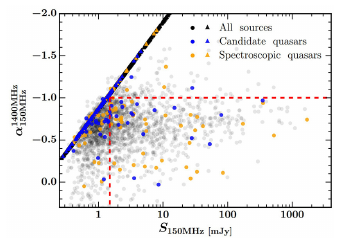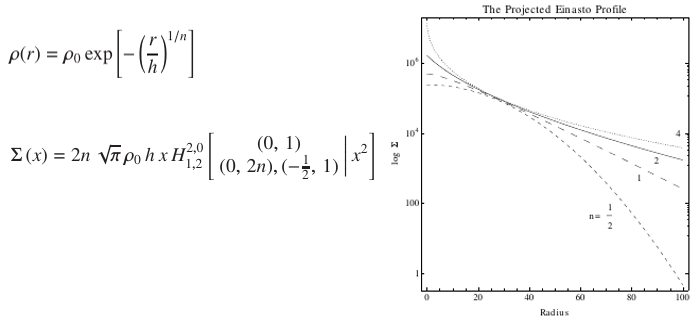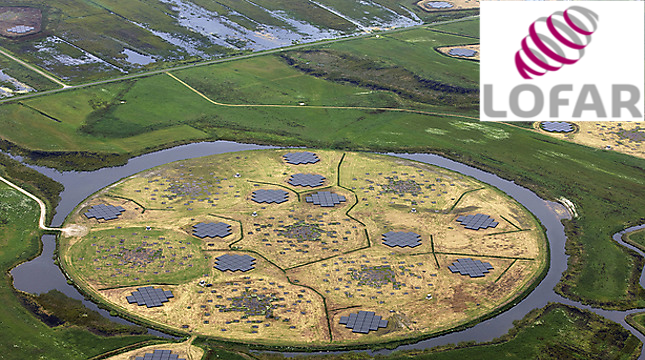 Deep LOFAR 150 MHz imaging of the Boötes field: Unveiling the faint low-frequency sky
Deep LOFAR 150 MHz imaging of the Boötes field: Unveiling the faint low-frequency sky
In Retana-Montenegro+18a, we conducted a deep survey (with a central rms of 55 μJy) with the LOw Frequency ARray (LOFAR) at 120–168 MHz
of the Boötes field, with an angular resolution of ~5″, and obtained a sample of 10 091 radio sources (5σ limit) over an area of 20 sq2.
The derived 150 MHz source counts present a flattening below sub-mJy flux densities, that is in agreement with previous results from high- and low- frequency surveys.
Additionally, we use our observations to evaluate the contribution of cosmic variance to the scatter in source counts measurements.
By comparing the induced scatter with that of counts obtained from depth observations scaled to 150 MHz, we find that the 1σ scatter due to cosmic variance is larger than
the Poissonian errors of the source counts, and it may explain the dispersion from previously reported depth source counts at flux densities S < 1 mJy.
 Extreme conditions in the molecular gas of lensed star-forming galaxies at z∼3
Extreme conditions in the molecular gas of lensed star-forming galaxies at z∼3
Using APEX/SEPIA observations, we explore the abundance of atomic carbon in lensed submillimeter galaxies at z~3 (Andreani, Retana-Montenegro+18).
We detected Atomic carbon (CI(2–1)) is detected in one of three targets, and marginally in another, while CO(7–6) is detected in all the targets.
By comparing the line ratios of these targets with those of nearby galaxies, we found evidence for some mechanism different than FUV heating
driven by star-formation processes as the dominant power source for their molecular interstellar medium.
 On the Selection of high-z quasars using LOFAR observations
On the Selection of high-z quasars using LOFAR observations
In Retana-Montenegro+18b, we presented a method to identify candidate quasars which
combines optical/infrared color selection with radio detections from the Low Frequency ARray (LOFAR) at 150 MHz.
We applied this method in a region of 9 sq2 located in the Boötes field, with a wealth of multi-wavelength data. Also, we investigated the effect of the
radio spectral index distribution on our selection of candidate quasars. We demonstrated that many quasars are detected only at 150 MHz as they have steep radio spectral indices.
 The clustering of radio-quiet and radio-loud quasars at 0.3 < z < 2.3
The clustering of radio-quiet and radio-loud quasars at 0.3 < z < 2.3
In Retana-Montenegro+17, we investigated the clustering properties of 45441 radio-quiet quasars (RQQs) and 3493 radio-loud quasars (RLQs) drawn from a joint use of the Sloan Digital Sky Survey (SDSS)
and Faint Images of the Radio Sky at 20 cm (FIRST) surveys in the range 0.3 < z < 2.3.
We found that RLQs are clustered more strongly than RQQs in all the redshift bins considered. This implies that RLQs are found in more massive host haloes than RQQs in our samples,
with mean host halo masses of ∼4.9×1013 h-1 M⊙ and ∼1.9×1012 h-1 M⊙, respectively. Comparison with clustering studies of different radio
source samples indicates that this mass scale of 1×1012 h-1M⊙ is characteristic for the bright radio-population, which corresponds to the typical mass of
galaxy groups and galaxy clusters.
 Analytical and Lensing properties of Einasto dark matter haloes
Analytical and Lensing properties of Einasto dark matter haloes
Recent high-resolution N-body CDM simulations indicate that nonsingular three-parameter models such as the Einasto profile perform
better than the singular two-parameter models, e.g. the Navarro, Frenk and White, in fitting a wide range of dark matter haloes.
In Retana-Montenegro+12a and Retana-Montenegro+12b , we studied the analytical and lensing properties of Einasto dark matter haloes using a Mellin integral transform formalism.
This enables arbitrary-precision calculations of the surface density and other lensing properties of realistic Einasto dark matter haloes.









